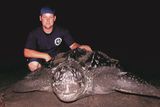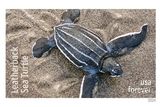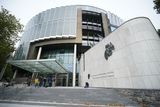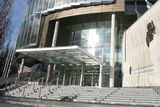Photo of sea turtle taken by Irish marine biologist used in US postal stamp


A photograph of a young leatherback turtle taken by an Irish marine biologist will be used in the latest US postal stamp.
Rowan Byrne from Sutton, Co Dublin, took a photograph of the leatherback sea turtle hatchling in 2006 while working on preventing the poaching of sea turtles in Dominica in the Caribbean.
The photo was taken on the seabed on Rosalie beach on the east coast of Dominica island, facing the Wild Atlantic.
Mr Byrne described having his photograph selected for the US stamp as a “great honour”, and he also hopes the stamp will raise awareness of this endangered species.
Leatherback turtle on the new USPS stamp. Photo: Rowan Byrne.
The Dubliner went to Dominica in 2003 to set up a sea turtle protection project on Rosalie Beach.
"The project was funded by Ms Beverly Diekel and Patris Oscar of Rosalie Bay Resorts. She hired me to do sea turtle research on the beach,” he said.
“Leatherback sea turtles were poached on the island as part of the island's culture.”
Leatherback sea turtle hatchlings are only two to three inches long, and when they hatch, they dig their way out of the sandy nest and scurry across the beach to the sea.
Gulls and crabs often scoop up the hatchlings before they make it to the water, resulting in only one in 1,000 turtles surviving to adulthood.
Hatchlings often die of dehydration if they don’t make it to the ocean fast enough.
Mr Byrne would relocate sea turtle eggs each night from the laying female into a new nest higher up the beach to save them from being washed away by strong Atlantic waves.
Hatchings would emerge from 70 to 80 days later, and Mr Byrne would visit the nests regularly.
The leatherback sea turtles remember where they are born as the Earth’s magnetic fields on this beach are imprinted into their minds. In the future, they will return to the nest again at Rosalie Beach.
The marine biologist was also tracking the turtles, and his satellite once tracked a nesting leatherback sea turtle in 2007. Mr Byrne named this turtle Doris after his mentor – Dr Fish, a marine biologist at Aberystwyth University.
After eight months, Doris followed Mr Byrne home to Ireland, swimming across the ocean from the Caribbean.
Mr Byrne was determined to dedicate his life to the sea from a young age, as his passion for marine biology stems from his childhood fascination with sharks.
Therefore, he decided to study marine biology soon after he finished school and has worked in the field ever since.
The new US stamp is due to be on pre-order sale from May 11 and will be on the general sale from June 11.
Join the Irish Independent WhatsApp channel
Stay up to date with all the latest news

















